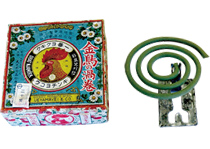Kincho coils, a regular part of everyone's life
“Better to be the head of a rooster than the tail of a bull”
The dream and determination behind the KINCHO trademark
While building a tradition spanning 140 years,
we have pioneered new technologies from the ground up.
140 years have passed since Eiichiro Ueyama, the founder of the company, met Mr. H. E. Amoore in 1885 and received seedlings of the Dalmatian pyrethrum plant, which did not grow in Japan at the time.
KINCHO has continued to propose healthy and pleasant living through creating epoch-making products, including the world's first mosquito coils developed from pyrethrum.
Innovative approaches have supported this long tradition.
We will continue to cherish this attitude of rising to challenges as we move forward to build new traditions for the next generation.

Portrait of Eiichiro Ueyama,
founder of KINCHO

The KINCHO trademark, passing on the founder's dream
The KINCHO trademark was registered in 1910.
Eiichiro Ueyama, the founder of the company, used this trademark to pass on his dream that his company's products would be well-known, loved around the world and help people's health.
Due to the high quality of the product and the traditional advertising strategy, KINCHO UZUMAKI (KINCHO’s Coil) has become a household name in Japan and around the world, just as Eiichiro dreamed.
-

The "Cultivation Handbook"
remained in print until 1935. -

KINCHO UZUMAKI (KINCHO's Coil)
(Around 1919) -

Mosquito coils rolled by hand (Around 1953)